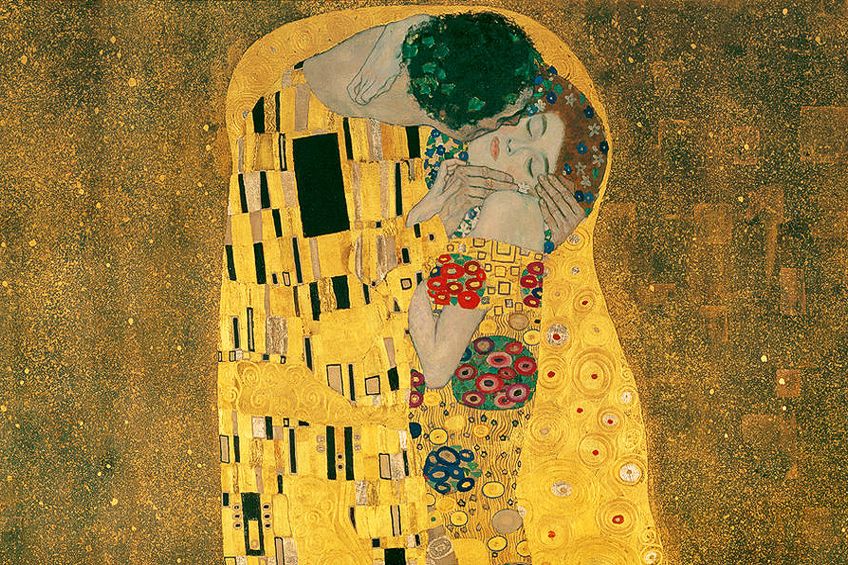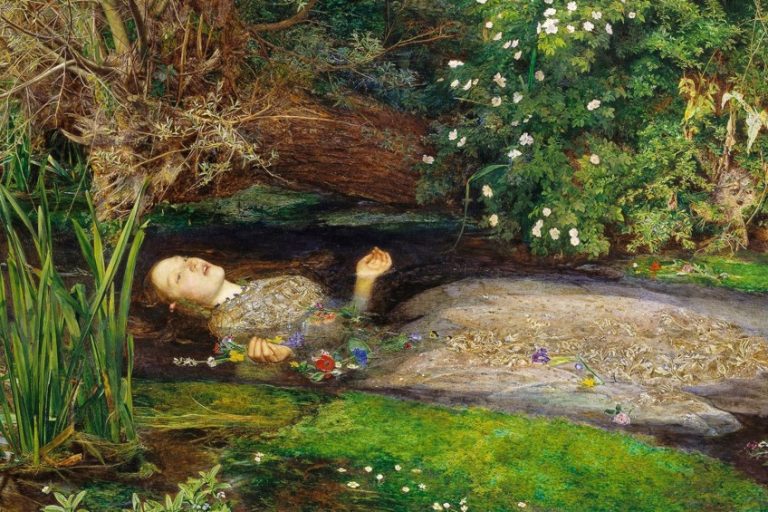The Kiss Gustav Klimt – An Analysis of Klimt’s Painting, “The Kiss”
The Kiss by Gustav Klimt is one of the most iconic paintings from the Art Nouveau period. Klimt painted this rich oil painting with added platinum, silver, and gold leaf in 1907, at the height of his “Golden Period”. The Kiss depicts a couple wrapped in a loving embrace in typical Art Nouveau style. Not only is this painting the most loved and celebrated of Klimt’s paintings, but it is also one of the most controversial.
A Brief Biography of the Painter of The Kiss, Gustav Klimt
It was in 1862 in Vienna that Austrian artist Gustav Klimt was born. His father, a gold engraver, was an immigrant from Bohemia, and his musically talented mother never realized her dream. Financially, the family struggled. From an early age, Klimt showed artistic talent. As a young teenager, he left school and began studying at the School of Arts and Crafts in Vienna. While he studied, Klimt readily accepted the classical and conservative training, and he focused his energy on architectural painting. While he was still at school, Klimt’s growing talent earned him several commissions.
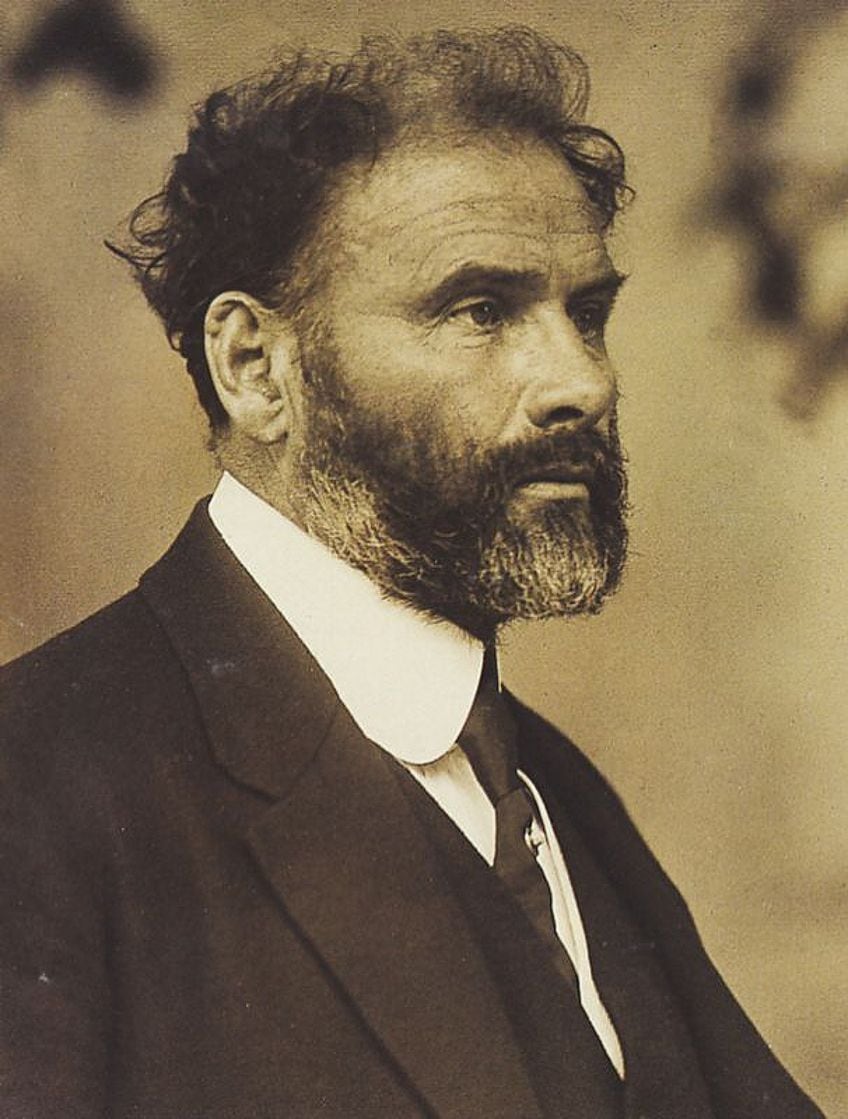
Following his time studying at the Vienna School of Decorative Arts, Klimt established an independent studio concentrating on mural painting with his friend, Franz Masch, and his brother, Ernst. This trio set aside their personal artistic preferences to accommodate Vienna’s aristocracy and high society. Much of Klimt’s early work with this trio, like his murals at the Vienna Burgtheater, was in the academic style of painting typical of the 19th century. The three artists received the Golden Order of Merit in 1888.
In 1892, following the untimely passing of his father and brother, Klimt began to embrace a more personal artistic style. This new style drew heavily on Symbolism and a broad range of influences outside of his classical training. Around 1897, we begin to see Klimt’s matured style emerging, and he established the Vienna Sezession.
This group of painters rejected the academic style in favor of a highly decorative and varied approach, similar to the Art Nouveau style. A primary aim of this group was to support young, non-traditional artists.
In the early 20th century, the University of Vienna asked Klimt to create three murals for their ceiling. Following its inclusion in the Secession exhibition, the Philosophy mural caused a scandal because it included dark figurative imagery and several nude human bodies. Despite the negative reception of much of Klimt’s work at this time, he was also reaching new heights of success. During Klimt’s Golden Phase in the early 20th century, he produced paintings using extensive gold leaf detailing and two-dimensional perspectives. It was in this period that Klimt painted The Kiss.
In terms of family life, Klimt had numerous affairs throughout his lifetime, and he is thought to have fathered around 14 children. In 1918, Klimt suffered a stroke leaving him paralyzed and hospitalized. During hospitalization, Klimt contracted pneumonia, and he died on February 6th, 1918.
The Kiss by Gustav Klimt: Historical Context
We need to explore the historical context in which Klimt painted this controversial and beautiful piece. Gustav Klimt had an Avante-Garde approach to art and was a member of the Secessionist movement. Klimt was also a pioneer of a European art genre called Symbolism. Symbolism shared similarities with the Art Nouveau and Arts and Crafts movements, particularly the mystical motifs and a personal approach to art.
Following his departure from the academic circles, Klimt painted three murals for the University of Vienna auditorium ceiling. Even at this early stage of his career, The Kiss painter received backlash and criticism for the erotic symbolism in his work. In the early 20th century, Klimt’s murals, like the Beethoven Frieze (1902), were characterized by arbitrary yet bold decorative patterns using color, linear drawing, and gold leaf.
Klimt was painting The Kiss (1908) during his Golden Phase. During this time, he also painted several portraits of fashionable Viennese women, including Adele Bloch-Bauer I (1907). Klimt treated the human figures within these paintings as two-dimensional, and they were surrounded by flat, brightly composed, and highly ornamental decoration.
During his illustrious career, Klimt found many admirers among ambitious young artists like Oskar Kokoschka and Egon Schiele. These artists endeavored to express the rawness of human experiences and feelings. Klimt also had several opponents within the Austrian art establishment as a result of his unashamed exploration of raw human sensuality and emotionality.

Inspiration and the Background of The Kiss
The motif of two embracing figures was common in Klimt’s works, particularly in the Beethoven Frieze and the Stoclet Frieze, which were precursors to The Kiss. There is much debate about the identity of the woman in this composition. Some believe the woman may be Emilie Floge, a close friend and companion of Klimt. Others think she bears more resemblance to a model known as Red Hilda, who posed for Klimt’s Woman with feather boa, Goldfish, and Danae.
After visiting Ravenna in Italy, where he saw the Byzantine mosaics by San Vitale, Klimt composed “The Kiss”. It is possible to see the Byzantine influence in many of Klimt’s paintings during his Golden Period. For Klimt, the two-dimensional nature of the mosaics only enhanced the brilliant effect of the gold.
Many art historians believe that the Byzantine influence may reflect Klimt’s movements towards more stability by using inorganic and static forms. The Kiss is the height of Klimt’s Golden Phase. Alongside The Tree of Life and The Beethoven Frieze, this piece completes an allegory representing the union of erotic and spiritual love and connection.

A Closer Look at The Kiss
The embracing couple takes center stage in this composition, with a dark and flat golden background framing them on either side. At the feet of the couple, we can see the edge of a flowery meadow beneath the woman’s bare feet. A flowing yellow dress decorated with organic floral patterns and circular shapes encapsulates the woman. The florals continue into her hair, and the man wears a crown of ivy. A similarly colored robe with subtle swirls and geometric patterns is draped over the man’s shoulders.
We cannot see the face of the man as he is bent over, cradling the woman’s face between his hands and kissing her on the cheek. The woman’s eyes are softly closed, with her face turned up towards the kiss and her one arm draping around his neck.
There are several theories about the intended identities of the man and woman wrapped in a loving embrace.
Some historians have argued that this composition may capture the kiss between Apollo and Daphne in the Greek myth, Metamorphoses. Although Daphne transformed into a laurel tree to escape the love of Apollo, he still embraces her. Perhaps the abundance of flowers on the female figure is a nod to this story? The woman’s bare feet are planted on the earth, and delicate golden threads appear to be holding her to it.
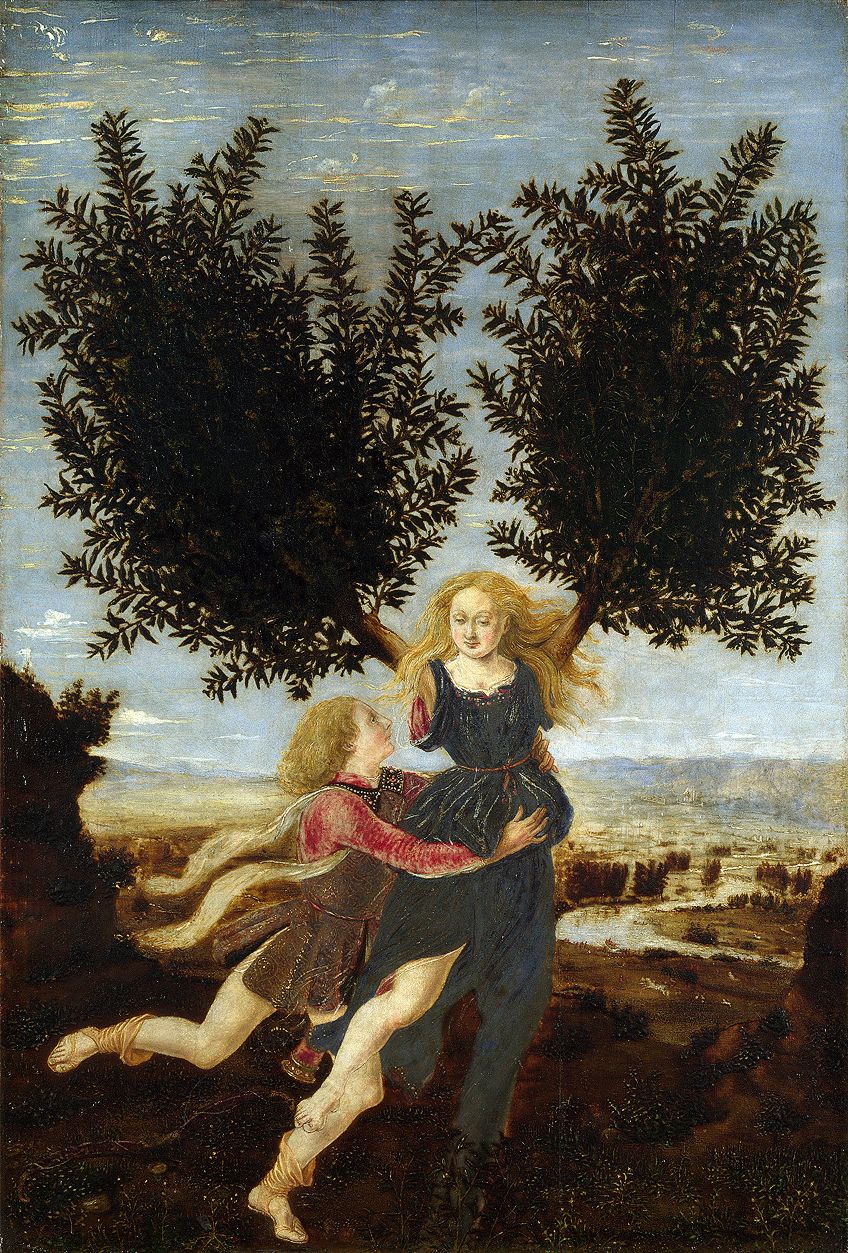
Other historians have suggested that The Kiss reflects the moment when Orpheus turns to caress his love Eurydice as he loses her forever, from the tale of Eurydice and Orpheus. Many cite the slightly translucent appearance of the woman’s face as evidence for this interpretation.
We can see a distinct duality between the masculine and feminine within this painting. The composition of the two figures with the man standing above captures the dominant, sometimes overpowering masculine force. The sharp and fairly heavy geometric blocks on the man’s robe echo this force. The kneeling and surrendering female figure and her flowing, more organic robe soften the composition and highlight the duality.
The soft spinning circles and wavy lines within the woman’s robe are reminiscent of Klimt’s Tree of Life. Although the naked bodies of both figures are hidden by the robes, this painting is imbued with a sense of eroticism and sensuality.
The Significance of The Kiss
The Kiss is an incredibly significant piece for several reasons. Not only is this one of Klimt’s most revered paintings, but it is also a celebrated example of the Art Nouveau movement. It is no wonder that The Kiss painting remains one of the most loved paintings of all time.
Reception of The Kiss
Shortly before painting The Kiss, Klimt’s Vienna Ceiling mural series had caused an uproar in artistic circles. Thought to be perverted and pornographic, these prior works cast a dark light on Klimt and his anti-popularist and anti-authoritarian views. Despite this reputation, The Kiss was received with much enthusiasm. The Austrian government even purchased the painting unfinished after being displayed in a public exhibition.
Aesthetic Significance of The Kiss
Not only does this piece represent the apex of Klimt’s Golden Period, but it is also a stunning culmination of many of the artist’s most distinctive stylistic fingerprints. The use of fine lines, vivid colors, and intricate and contrasting patterns make this painting unmistakably Klimt’s.
Delicate and Fine Lines
The fine lines used to construct the human figures and the intricate detailing around them is characteristic of Gustav Klimt. We can see Klimt’s clean and skillful draughtsmanship most clearly in the delicate face of the female figure. Her facial features are soft and delicate, with a carefully carved nose, intricate eyelashes, and daintily bent hands.
Despite his clear talent, Klimt, like many artists, was uncertain of his artistic ability. He once said that although he believes that he can draw and paint, and others may too, he cannot be certain that it is true. When we look at The Kiss today, we cannot disagree more with Klimt. This painting is undoubtedly one of the most famous and celebrated.
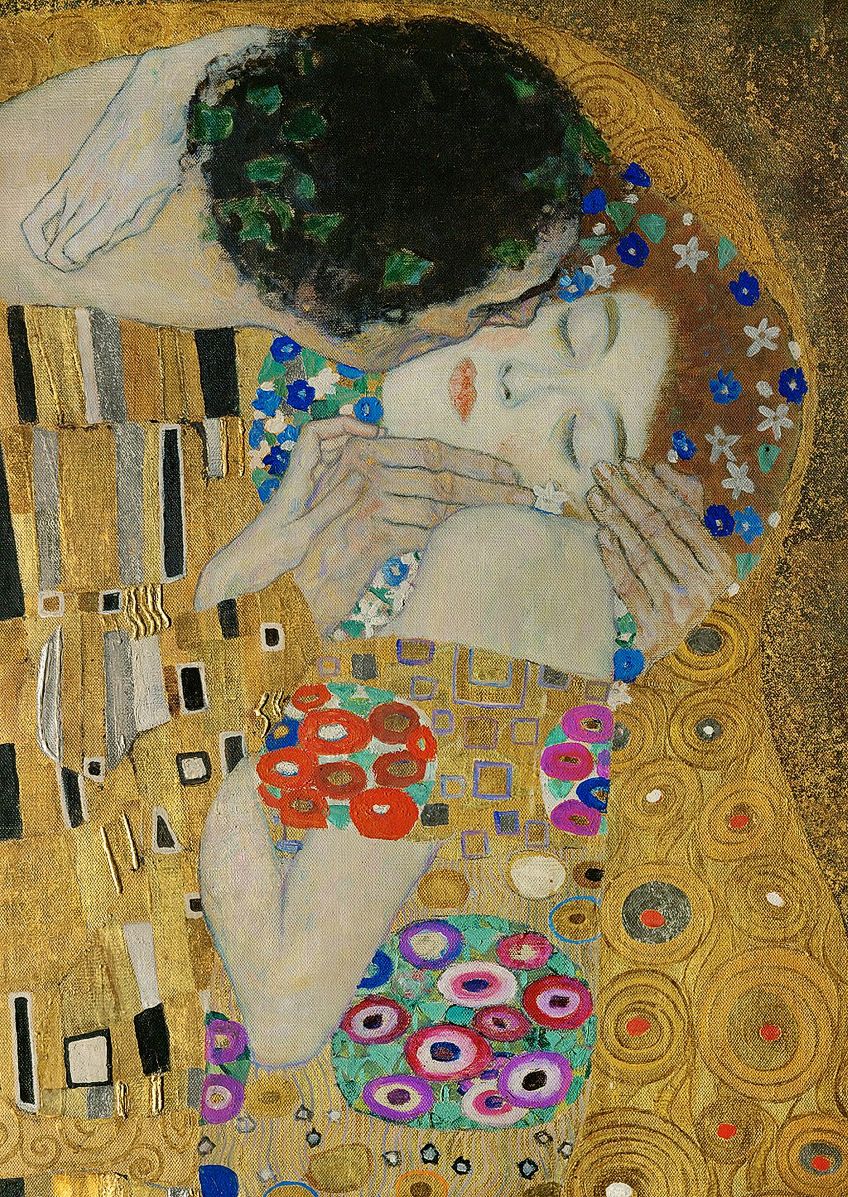
Intricate and Dancing Patterns
The decorative elements within this painting are seemingly endless. Each inch of the canvas is packed with different decorative textures and designs. Klimt’s highly decorative style symbolizes his rejection of the confines of the classical tradition. Within The Kiss, there are countless and often juxtaposing patterns.
The man’s robe is adorned with a geometric pattern of rectangles, interspersed with the soft swirls that feature in many of Klimt’s paintings. In fact, many of the patterns used in The Kiss are motifs that Klimt employs throughout his oeuvre. Klimt’s incredible attention to detail is highlighted by his use of rectangular blocks and radiating rings to concentric squares and swirling spirals.
Bright and Luxurious Color Schemes
The Kiss painter’s liberal use of gold inspired the name of his Golden Period, but he also used a broad range of radiant colors in all of his paintings. In The Kiss, we can see these vibrant colors in the stylized flowers throughout the composition.
You can see the lilac and dark purple flowers in the woman’s hair, which are completely different in color and shape from the field of wildflowers beneath her feet. Patches of similarly colored flowers adorn the woman’s robe with bright oranges, pinks, and purples. Not only do the colors add vibrancy and life to the composition, but they also contrast beautifully with the shades of gold that cover the majority of the canvas.
Interesting Facts You May Not Know About The Kiss
We have covered much of the history and significance of this well-known painting. There are, however, some little-known facts about the piece and the artist that we think are particularly fascinating and add to the rich history of Klimt and his unique style.

The Price
The price paid for The Kiss painting by the Austrian government was both record-breakingly high and an incredible bargain. When the Austrian government bought The Kiss from Klimt before he finished it, they paid a record-breaking 25,000 crowns for the painting. Today, this sum translates to around $240,000. In terms of the art market today, this price may not seem that impressive. Before this sale, however, 500 crowns was the record for the most expensive painting.
Although the price was high in the early 20th century, it is relatively paltry today. The Kiss is an Austrian national treasure, and it is unlikely that the Viennese museum would ever consider selling it. If it were to be put on auction, it is likely that The Kiss would once again break sales records. In 2006, Klimt’s portrait of Adele Bloch-Bauer sold for $135 million, and at that time, it was the highest price ever paid for a painting. We can only imagine what The Kiss would be worth at auction today.
The Kiss Is an Amalgamation of Different Artistic Styles
We have already discussed how The Kiss painting is an example of Klimt’s unique Art Nouveau style. Several other schools of art were an inspiration for this painting. The mosaics of the Byzantines inspired Klimt’s extensive use of gold leaf during this time. It was also the Byzantine style that influenced Klimt’s use of two-dimensional forms that make the gold pop. The composition of this piece is thought to be inspired by Japanese prints. This influence is also evident in many early Impressionist paintings. We can see the Arts and Crafts influence in the contrasting patterns in the couple’s robes.
The Kiss Was a Departure From Klimt’s Previous Work
Klimt very rarely included any male figures in his compositions, preferring to focus on the eroticism of the female form. The inclusion of a man, despite his hidden face, is an unusual feature in this painting. Another way that this painting departs from Klimt’s earlier work is in the dressing of the figures. The nudity of many of Klimt’s earlier paintings had caused shock and controversy, so to have two fully clothes figures makes this painting relatively conservative. Perhaps this modesty was as a result of the latest fall-out over the Vienna Ceiling paintings.
There Is a Coin with the Artist of The Kiss, Gustav Klimt
In 2003, a commemorative 100 Euro gold coin was issued by the Austrian mint. On one side of the coin is the bust of Gustav Klimt, and on the other is a small etching of The Kiss. Klimt and The Kiss are both significant and celebrated parts of Austria’s history, and it seems fitting that Klimt’s Golden Period is commemorated in this way.

IMAGE LEFT: Front of 50 Euro gold coin commemorating Gustav Klimt’s The Kiss; Gustav Klimt, Public domain, via Wikimedia Commons | IMAGE RIGHT: Back of 50 Euro gold coin commemorating The Kiss by Gustav Klimt; Ich, KenzoMogi, CC BY-SA 3.0, via Wikimedia Commons
Further Reading About Gustav Klimt and The Kiss
It is not possible to fully explore the biography of Gustav Klimt in a single article. We have two book suggestions for those interested in learning more about the life and works of Klimt and the Art Nouveau movement. You can also learn more in our article about the most famous Gustav Klimt artworks.
Gustav Klimt: Drawings and Paintings (Bibliotheca Universalis)
This expansive collection of all of Gustav Klimt’s works by author Tobias Natter guides you through the ever-evolving style of one of Austria’s most celebrated artists. From his involvement in the Secessionist movement to his Golden Period, this illustrated anthology of Klimt’s life and works is ideal for anyone interested in the art of the early 20th century. Beautiful photographs of Klimt’s murals and paintings are accompanied by insightful historical commentary and material from Klimt’s own archives. This book is pocket-sized, making it perfect as a traveling companion or display on a bookshelf.
- Following the life and artworks of Gustav Klimt (1862–1918)
- A collection of Klimt's major works in context
- Top-quality illustrations, including new photography
Klimt (Basic Art Series 2.0)
If you are looking for more biographical information about the famed Gustav Klimt, you need not look any further than this illustrated hardcover book. Covering his early life, artistic development, and lasting influence, this book by Gilles Neret is a must-have for anyone who loves Klimt. In this book, you will gain insight into the scandal surrounding many of Klimt’s nude paintings and explore the reasons as to why Klimt is one of the most loved and influential artists of the 20th century.
- Presents Klimt's pictorial world of decoration and desire
- Includes a detailed chronological summary of the life and oeuvre of Klimt
- Approximately 100 illustrations with explanatory captions
From luxurious color pallets with gold leaf to intricate and organic patterns, the paintings of Gustav Klimt have captured the hearts and imaginations of people across the world. “The Kiss” is one of Klimt’s most famous paintings that captures the height of his style and talent.
Take a look at our The Kiss painting webstory here!
Alicia du Plessis is a multidisciplinary writer. She completed her Bachelor of Arts degree, majoring in Art History and Classical Civilization, as well as two Honors, namely, in Art History and Education and Development, at the University of KwaZulu-Natal, South Africa. For her main Honors project in Art History, she explored perceptions of the San Bushmen’s identity and the concept of the “Other”. She has also looked at the use of photography in art and how it has been used to portray people’s lives.
Alicia’s other areas of interest in Art History include the process of writing about Art History and how to analyze paintings. Some of her favorite art movements include Impressionism and German Expressionism. She is yet to complete her Masters in Art History (she would like to do this abroad in Europe) having given it some time to first develop more professional experience with the interest to one day lecture it too.
Alicia has been working for artincontext.com since 2021 as an author and art history expert. She has specialized in painting analysis and is covering most of our painting analysis.
Learn more about Alicia du Plessis and the Art in Context Team.
Cite this Article
Alicia, du Plessis, “The Kiss Gustav Klimt – An Analysis of Klimt’s Painting, “The Kiss”.” Art in Context. February 23, 2021. URL: https://artincontext.org/the-kiss-gustav-klimt/
du Plessis, A. (2021, 23 February). The Kiss Gustav Klimt – An Analysis of Klimt’s Painting, “The Kiss”. Art in Context. https://artincontext.org/the-kiss-gustav-klimt/
du Plessis, Alicia. “The Kiss Gustav Klimt – An Analysis of Klimt’s Painting, “The Kiss”.” Art in Context, February 23, 2021. https://artincontext.org/the-kiss-gustav-klimt/.


